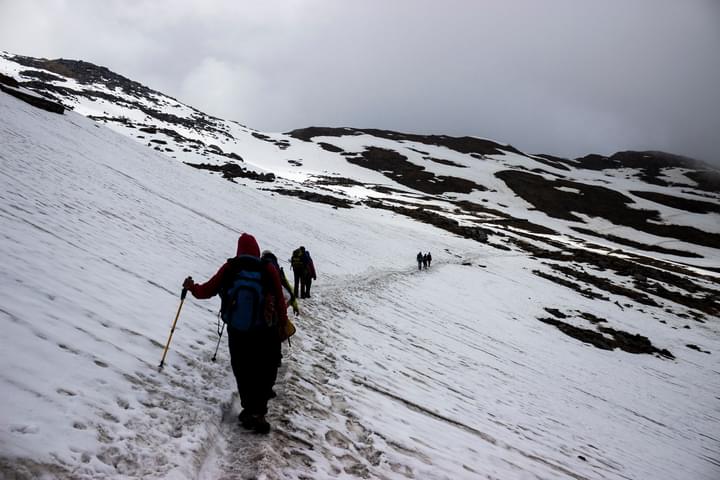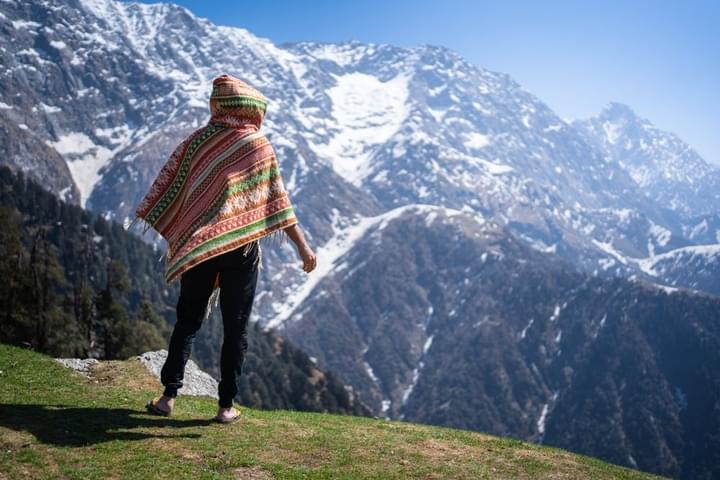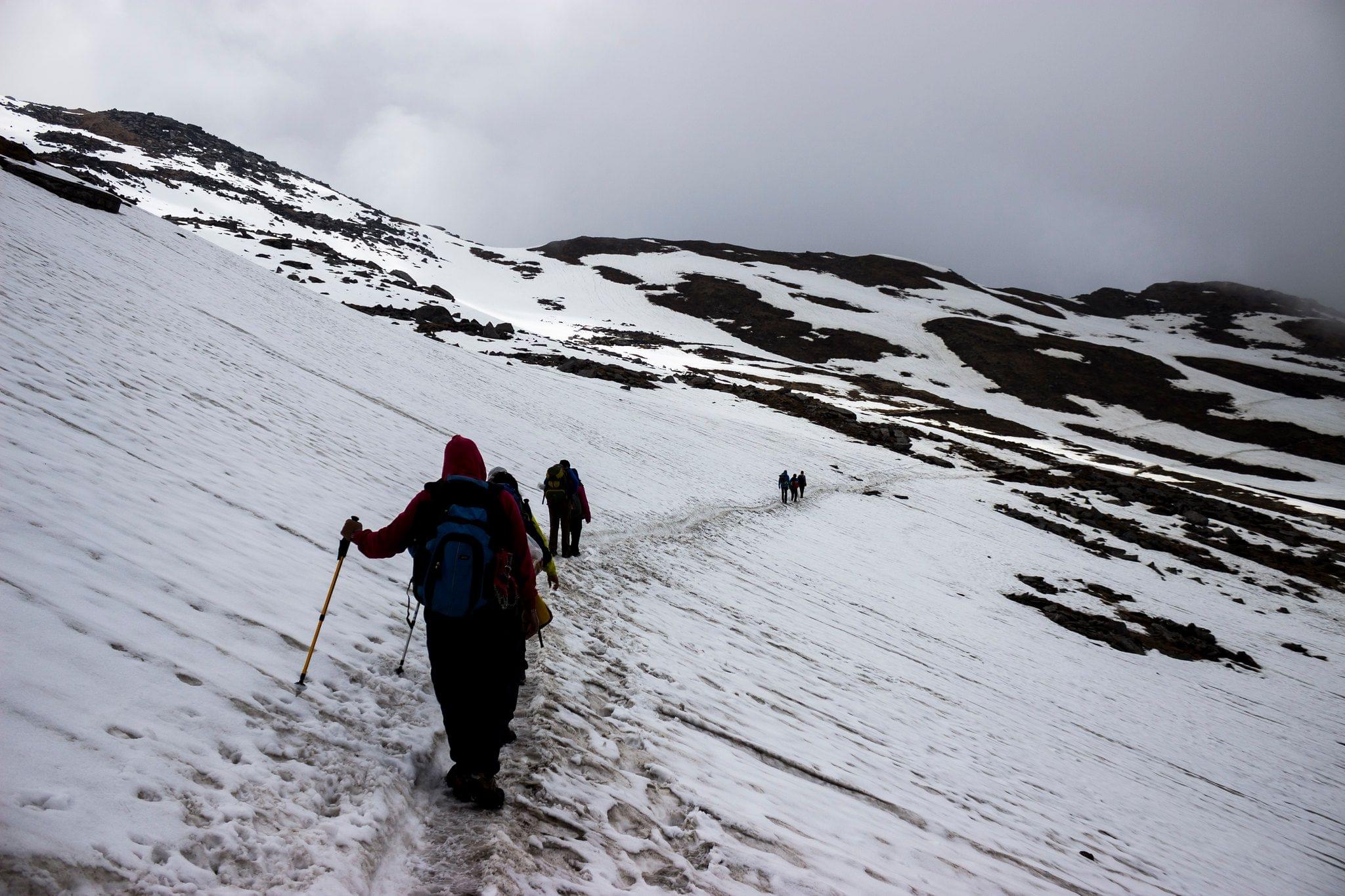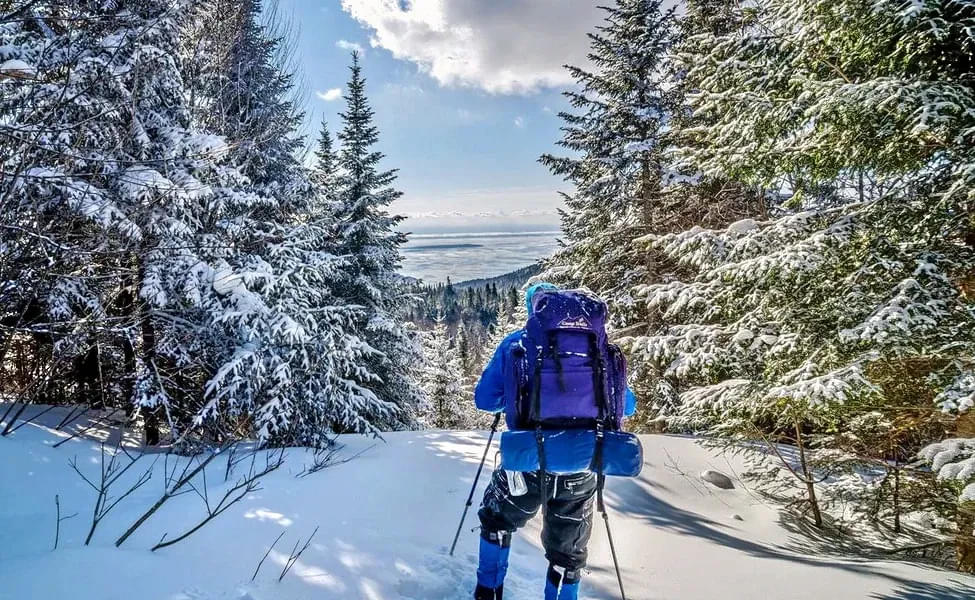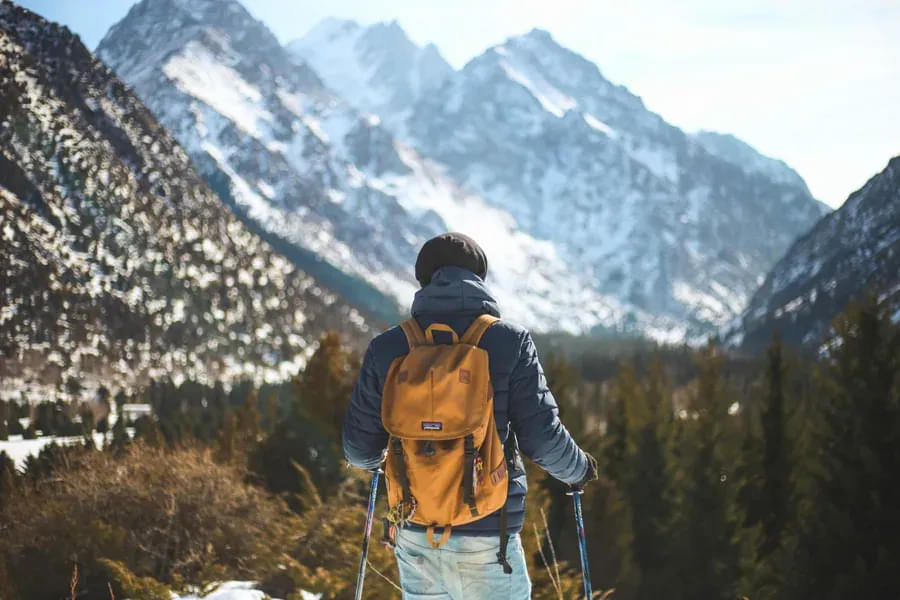Rupin Pass Trek Overview
Book Rupin pass Trek Package
Quick Facts of Rupin Pass Trek
- Maximum Altitude of Rupin Pass Trek - 15250 ft
- Duration - 8 Days
- Rupin Pass Trek Distance - 52 Kms
- Trail type - Difficult
- Airport - Jolly Airport, Dehradun
- Snow Season - Winter, usually starting in the month of November
- Base Camp - Dhaula hamlet
- Best Season - May-June (Pre Monsoon), Sep-Oct (Post Monsoon)
- Region - Uttarakhand
- Who Can Participate - The minimum age required to embark on the most thrilling trek is 15 years. The maximum age for this trek isn't specified, however if you're above 70, it would be advisable to proceed with extreme caution.Participants are required to have previous experience of at least one high altitude trek of upto 5,000/16,400 ft.
Short Itinerary for Rupin Pass Trek
Rupin Pass Trek Detailed Itinerary
Dehradun to Mori (1100m) to Dhaula (1800m)
Travel to the base camp for 7-8 hours covering 195 kilometers.
Transfer from Dehradun railway station to Mori (1100m).
Witness the beautiful village of Mori on the banks of the beautiful Tons river.
From Mori, proceed through the pine woodland across the Tons river.
Reach Netwar to pay homage at the sacred place of Pokhu Devta.
Move to the base camp of Dhaula hamlet, located near Rupin Gad at 1800 m.
Rest in the tents overnight before starting the trekking activity.
Dhaula (1800m) to Sewa (2100m)
Ascend through the rhododendron woodlands and lush fields to freshen your mind.
Arrive at Sewa after trekking for 3-4 hours to rest overnight in tents.
Sewa (2100m) to Jakha (2700m)
Move through the charming hamlets for a sneak peek into their cultures.
Enjoy ascending the forests and get awestruck by a glimpse of the snowy ridges of the Dhauladhar range.
Reach Jakha, the final hamlet for day three to interact with the locals.
Retreat to your tents for a blissful sleep.
Jakha (2700m) to Suruwas Thach (3250m)
Trek to the dewy and enchanting meadows of Suruwas Thach.
Cross the river and climb through a jungle stretch to arrive at Rupin valley’s entrance.
Enjoy the delightful initial look of Rupin Waterfall after trekking for 5-6 Hours.
Rest overnight in tents across the lush greenery of the environs.
Suruwas Thach (3250m) to Dhanderas Thach
Move through the picturesque meadow to refresh yourself.
Trek 5 kilometers through the steep trail between snow stretches to reach the camping area in 4 hours.
Sleep overnight in the tents to unwind for the day.
Dhanderas Thach to Upper Waterfall Camp
Get a rush of adrenaline by steep trekking for three hours.
Trek during the early morning hours through the snowfields and rocky trails.
You might use ropes in some of the stretches to reach the top.
Ascend for 2 hours on the trail of Rupin Pass through the steep snow and reach the top at an altitude of 4650 meters.
Enjoy the mesmerizing looks of the Himalayas and the mountain range of Kinner Kailash and Charang La.
Rest for a bit to start descending a couple of hours to reach Ronti Gad Pastures.
Rest in the tents overnight after the long day of the trek.
Upper Waterfall to Rupin Pass to Ronti Gad
Descend 10 kilometers down towards Sangla in 11 Hours.
The trail will reward you with the charming looks of the Baspa River and hamlets of Sangla Valley.
Sip a hot masala tea in Sangla to rest later the night in tents.
Ronti Gad to Sangla
Have breakfast early to get transferred to Shimla in 6 hours.
Enjoy the ride amidst the greenery to reach Shimla by afternoon, ending Rupin Pass Trek Package.
Know Before You Go to Rupin Pass Trek
Make sure to train yourself well before the trek to reach the endurance level of walking 10 kilometers in 60-70 minutes.
Visit a doctor before the trek to assess your fitness level and receive any necessary health checks.
Wear sunglasses to protect your eyes from UV rays, as snow reflects the sun and can cause snow blindness.
Have 7-9 hours of sleep on the days of your trek because moving restlessly will impede your journey and make you uncomfortable.
Carry a 50-60 liter backpack to store all of your essentials.
Trekking poles can cut your energy consumption by 30-40% by increasing your speed and decreasing your trekking time.
Practice ventilation techniques as atmospheric pressure drop at such high altitudes, resulting in reduced oxygen inhalation.
The sudden drop in oxygen levels can cause headaches, hypoxic conditions, vomiting, and a variety of other health issues.
Carry medications and take the necessary precautions to avoid these.
Wear thermal layers or multiple layers of clothing to keep yourself warm.
Cover your head as cold waves strike your head and face, lowering your body temperature.
Climbing too quickly will tire you out and may result in an accident.
Use ropes where necessary in Rupin Pass.
The trek starts from Dhaula to reach Sewa at an altitude of 2100 m. You will pass through the rhododendron woodlands and green landscapes to arrive at Sewa Campsite. You will travel through multiple villages to reach Jakha hamlet at 2700 m.
The next day, you will cross meadows, rivers, and jungle stretches to reach Suruwas Tach. From this place, you trek through the meadows to reach the camping area at Tach. A steep trek of 2-3 hours requiring the use of ropes lies ahead of this point.
After reaching the Upper Waterfall Camp, the highest point at 15,250 meters, you will witness the heavenly look of the Kailash Range and the Himalayas, the top point of Rupin Pass Himalayan trek. You will descend to Ronti Gad for trekking about 10 kilometers.
After resting at the Ronti Gad campsite for the night, you will be taken to Shimla.
The trek starts from Dhaula base camp, and you can access this area via Dehradun.
By Air: You can use Jolly Grant Airport located at a distance of 20 km from Dehradun city center.
By Train: You can reach Dehradun Railway Station as it has train connectivity with several cities such as Delhi, Mumbai, Kolkata, Chennai, Allahabad, Lucknow, Varanasi, Ujjain, etc. From the railway station, you can take a cab or board a bus to reach Dhaula.
By Cab/Taxi: From Dehradun ISBT, you can travel via a private taxi or board a local state transport bus to reach the base camp.
Rupin Pass Himalayan trek is open for a few months in a year, mainly for two seasons Summer and Autumn- making these seasons the best time to visit.
- Summers: From Mid-May to the end of June.
The temperatures in this season may vary between 13 °C and 17 °C during the day and drop to zero at night. Snow is present throughout the season at the lower waterfall campsite and upper waterfall campsite. In mid-June, chances are that snow would be present only on the upper waterfall campsite. This season will make you witness multiple snow bridges throughout the trek. The most beautiful ones are after the forest section beyond Jaka and near the Rupin Waterfall. The snow-covered area from Dhanderas Tach to Ronti Gad and the famous snowfields of Rata Pheri is the highlight of this season. Towards mid-June, wildflowers bloom to add more greenery and glory to this trek.
- Autumn: From September to October
The temperatures in this season may vary between 12 °C and 16 °C during the day and drop to zero to -4 or -5 °C at the higher campsite. The Autumn season has its own benefits as the Jiskun valley turns green with an even more number of visible waterfalls. The meadows of Thatch bloom with wildflowers. During this season, the trail is all in the colors green with the absence of snow, making it one of the best times for Rupin Pass trekking.
What to Pack for Rupin Pass Trek?
Winter weather necessitates the covering of thermal clothing with inners, sweaters, jackets, and coverage even on legs.
You can beat the frigid temperatures on your trek by wearing multiple layers of T-shirts, which you can add/remove as the weather changes.
Scarves, caps, and woolen ear coverings are required because cold waves cause you to lose major of your body heat through your head. As a result, the head must be completely covered.
Carry several pairs of gloves and socks.
You must carry two trek pants with zippers.
In case of an emergency, you should carry rainwear.
Trekking shoes that are appropriate for hills and mountains, particularly snow.
A 50-60 liter backpack is required.
Medicine kit.
UV-protected sunglasses for preventing snow blindness.
Sunglasses and sunscreen for sun protection.
Instead of a single beam or torch, carry a headlamp that covers a large area. The headlamp will free up your hand to perform another task.
A pair of trekking poles for balance and stability as you ascend. The poles would reduce your energy consumption by 30-40%, increasing your speed and shortening your journey time.
Toiletries
Toothbrushes
Toothpaste
Soaps
Tissues
Moisturizer
Cold coral
Sanitizer
Anti-fungal cream
Eatables
- Water bottles, snacks such as biscuits, protein bars, glucose-based chocolates, cup noodles, dry fruits, and quick energy bites must be carried on the journey to Rupin Pass top point.
Cutlery
Carry a leakproof lunch box
Mug
Spoon
Disposable plates and glasses.
Other Essentials
Plastic covers to keep your used clothes separate from your new clothes and food.
Carry chargers, power banks, and a magnetic compass to ensure proper communication and navigation.
General Trivia About Rupin Pass Trek
In the autumn, the Apple season begins in Uttarakhand and Himachal Pradesh. Apart from the views encountered on the trek, you will come across plenty of apple trees. Friendly localities of the region may even invite you to their homes for eating apples.
Jhaka Village is also known as the hanging village due to its presence at a high altitude. This village is a friendly stop to the difficult terrain of the Rupin Pass. A temple in the village is situated on a rock that gives you a view of the entire village. The temple walls of the village are carved with coins of pillars, wood, and many other things with precession.
Jiskun has a strange practice of extracting honey from the honey bees as they keep small boxes for them to form a hive.
Why to Go for Rupin Pass Trek?
You May Also Book
FAQ's for Rupin Pass Trek
How Difficult is the Rupin Pass Trek?
Rupin Pass trek is graded as a moderate-difficult level 2 trek. It is because the trek has a fast-changing trail which sometimes is a simple walk but changes to a steep climb rapidly. The terrain becomes difficult to walk, ropes are used in the trek. The total trek distance is 52 kilometers for 7 days, an average of 7 kilometers per day. In reality, you would be walking 10 kilometers on multiple days of the trek. This makes the person go through constant altitude loss and gains within the journey. To reach 15,250 ft at the top, the trek follows the steep path from Dhanderas Tach onwards. Even in summers, snow bridges and snow fields are there to be crossed. For choosing this Himalayan trek, you should possess a cardiovascular endurance of moving 10 kilometers in 60-70 minutes before the actual trek starts. Prior practice is needed to gain this endurance by running, swimming, cycling, and climbing stairs without stopping.
What fitness levels are required in Rupin Pass Trek?
The Trek is rated from moderate to difficult as it requires you to ascend and descend 52 km, walking an average of 7 km daily. You have to be physically sound and active to cover this distance. For this, prior fitness training is required. You can start to practice covering 10 km in 60-70 minutes.
Where is the Rupin Pass Trek Located?
Rupin Pass Himalayan trek happens to be in the Garhwal Mountain Region of Uttarakhand at the border of Himachal Pradesh.
Is Rupin Pass Trek safe?
Yes, Rupin Pass Himalayan Trek is safe as the trail is not always difficult and steep. Only some parts of the trek require extra effort. You just need to be attentive while trekking to enhance your thrilling experience.
Will I find snow during the Rupin Pass trek?
If you trek during the summers from Mid-May to June, you will find beautiful snow bridges and snow fields at the lower and upper wall campsite. During the Autumn season around September-October, you won’t find snow instead the valleys would be greener.
Is offloading is available at Rupin Pass trek?
You can offload, but it will cost you more. However, since it would take more effort, it is advised that you carry backpacks alone. This is due to the fact that a true trekking experience is all about challenge and adventure.
Is there an ATM service near the Rupin Pass?
The last ATM before the start of your trek is in Purola, which is on the route to Dhaula.
.png?w=auto&h=400)
